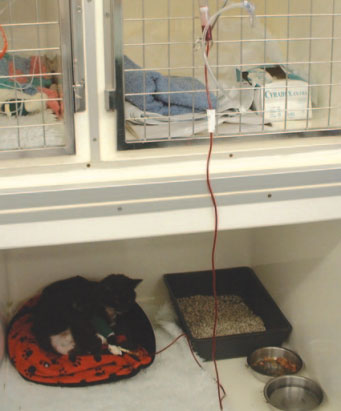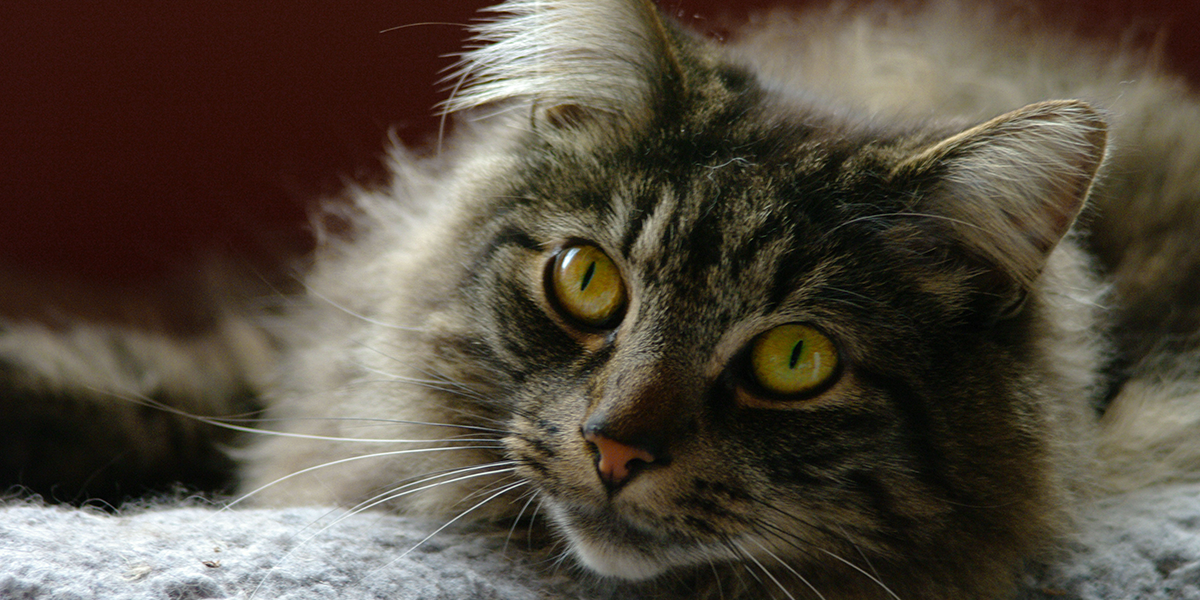A blood transfusion can be a life-saving procedure.
The first documented human-to-human transfusion was done as early as 1818, but transfusion medicine really took off in the 1920s and 1930s when anti-coagulants were introduced, allowing blood storage and the development of blood banks. Human transfusion medicine has developed into a very advanced science.
In veterinary medicine, transfusions are undertaken less often, but can have a vital role in emergency and critical care situations. As in humans, a blood transfusion for a cat can be a life-saving procedure. However, feline blood transfusions need to be undertaken with care — there are practical difficulties associated with collection and storage of the blood, and a higher risk of complications, for both donor and recipient, than in canine blood transfusions.

When is a blood transfusion needed?
A blood transfusion provides an immediate supply of red blood cells, which are essential for carrying oxygen around the body. A blood transfusion can therefore be life-saving in severe anaemia. However, blood contains many other elements which may also be useful. When blood is transfused the three major elements that can be provided are:
- Red blood cells (erythrocytes): these are the cells that carry oxygen around the body and are given to treat anaemia. A simple blood measurement called the packed cell volume (PCV) can be used to estimate the number of red blood cells. In a normal cat, the PCV is usually between 25% and 45%. Although each individual situation varies, a blood transfusion will normally be required if the PCV falls below 10-15%
- Plasma: this is the fluid component of blood (within which the red cells are suspended). It contains many proteins with essential functions. Albumin – this is the major protein in blood, and importantly helps to hold fluid (water) within the circulation. Other chemicals and hormones may be transported around the body being bound to albumin. Clotting factors – these are critically important proteins in the blood that cause blood to clot when a blood vessel is damaged. Inflammatory mediators – a variety of proteins are produced during inflammation to help fight infections and regulate the inflammation
- Platelets: these are very small cells in the blood that work alongside clotting factors to allow blood to clot and prevent prolonged bleeding after injury
Blood can potentially be separated into these three components (red cells, platelets and plasma), and this is commonly done in human medicine so that the three elements can be used individually when needed. However, while this approach is sometimes used with dogs transfusions, it is much less common in cats, partly because cat blood (red cells in particular) cannot be stored for any length of time so fresh blood is usually collected for a transfusion.
Blood groups and blood compatibility
There are three major blood groups in cats — A, B and AB. Group A is the most common while group B is common in some pedigree breeds. Group AB appears to be rare in all breeds.
Cats given a non-compatible blood transfusion can develop severe life-threatening transfusion reactions, because cats can have naturally-occurring antibodies (a part of the immune system) in their blood against red blood cells of the wrong type. This is particularly true of type B cats that always have high levels of antibodies against type A blood (and will react badly if given type A blood), but can also be true of type A cats.
The incompatibilities and risk of severe transfusion reactions mean that cats should only ever receive a matched blood transfusion.
More recently a second important blood group system has been identified in cats. Cats may be Mik positive or Mik negative and incompatible Mik transfusions may also cause reactions, but the frequency and significance of this not entirely clear at present, although it appears some incompatibility reactions can be severe.
Reactions to other blood components such as white blood cells, platelets and plasma proteins can also occur occasionally, but these tend to be milder and are usually manageable.
Avoiding transfusion problems
Although transfusions can be life-saving, because of the possibility of severe transfusion reactions, great care is required to ensure the transfusion does not do more harm than good.
- Steps must be taken to ensure, as far as possible, that the donor and recipient cats’ blood are compatible. As a minimum, both cats’ A/B/AB blood group must be checked, and ideally further cross-matching should be done to identify Mik antigen and other incompatibilities
- The donor cat should be screened for blood-borne infections including feline leukaemia virus (FeLV), feline immunodeficiency virus (FIV), and Mycoplasma haemofelis (the cause of feline infectious anaemia)
- Great care is required during transfusion to avoid overloading the recipient cat’s circulation, as this can lead to heart failure – generally a transfusion needs to be given slowly because of this
- Recipient cats should be monitored very closely, especially during the start of the transfusion, to identify any reactions. The first few millilitres of blood should be given very slowly (eg, 1 ml/kg/hr for the first 30 minutes) so that any reactions can be identified and the transfusion stopped.
Ensuring the safety of the blood donor
Collection of blood from a donor cat must be undertaken with care to ensure risks are kept to an absolute minimum. Current recommendations are that the donor cats must be:
- Healthy, fully vaccinated and ideally living wholly indoors
- Less than 8 years old
- Over 4.5 kg lean bodyweight
- PCV must be over 30% and ideally over 35%
- Free of FeLV/FIV/Mycoplasma haemofelis
- Not stressed by the visit to the vet
Even when all these criteria are met, donating blood is not without its risks – low blood pressure can occur in the donor after removing a significant amount of blood and occasionally previously undetected heart disease may become apparent after a cat donates blood – the altered blood volume may induce heart failure and death. Although uncommon, an ultrasound scan of the heart may be helpful in identifying such cats before they donate blood.
Feline blood banks
With the precautions necessary for blood transfusions, it is not always easy to find a suitable donor cat in an emergency situation.
Having access to a local blood bank, where blood and blood products are stored, and can be ordered for courier delivery when needed, would be ideal, providing a source of safe, pre-tested blood of known blood. However, this is not easy with cat blood, partly because their red blood cells can only be stored for a very limited time. Blood banks may become more widely available in the future, but are currently very rarely an option.
Some clinics maintain a small group of cats that they keep specifically for blood donation, and cats requiring a transfusion can be referred to such clinics. Another practical solution that some vet clinics adopt is to maintain a register of owners who are willing to allow their cats to be used as donors. This can be very helpful, although there is no perfect solution.
Thank you for visiting our website, we hope you have found our information useful.
All our advice is freely accessible to everyone, wherever you are in the world. However, as a charity, we need your support to enable us to keep delivering high quality and up to date information for everyone. Please consider making a contribution, big or small, to keep our content free, accurate and relevant.
Support International Cat Care from as little £3
Thank you.
Donate Now


